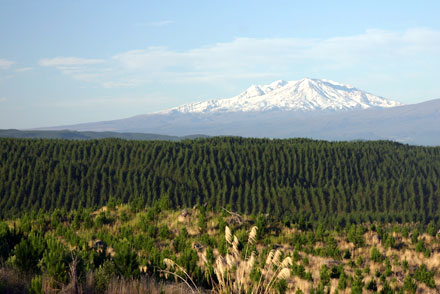
Increased levels of carbon dioxide in the atmosphere look likely to benefit some plants more than others, Rangitikei farmer and forester Denis Hocking says. Sources: New Zealand Herald, Wanganui Chronicle
In temperate climates like New Zealand’s, it’s looking as though forestry species like pines and eucalypts will benefit, while pasture grasses will not.
It appears the extra CO2 only helps if no other nutrients are lacking.
Mr Hocking has been reading about soil fungi in the journal Science, and says these virtually invisible life forms seem to be flavour of the month.
Less than 10% of the New Zealand species have been identified. But collectively soil fungi are becoming better known, and more talked of, like the many microbes in the human gut.
Studies have found that some plants grow faster in an atmosphere with more CO2 , and keep growing faster. Others grow faster, but only for a while. Some don’t grow faster at all.
What’s common to those that show sustained and increased growth is the presence of particular species of soil fungi coating the outside of their small roots. They’re called ectomicorrhizal fungi.
Pines, douglas fir and eucalypts have them, and they can be visible as a white coating on fine roots. It seems these fungi spread out into the surrounding soil and pick up water and nutrients, especially nitrogen, to contribute to the trees.
It’s a symbiotic relationship – they get carbohydrates in return.
New Zealand’s plantation forestry and indigenous forests tend to be on poorer soils. The fungi help them survive there.
Pines, douglas fir and eucalypts could all grow faster under the higher CO2 already happening with climate change. There is also evidence that ectomicorrhizal fungi spread substances between trees, even between trees of different species provided they have the same fungi.
The presence of these fungi has added credence to organic growing theory, Mr Hocking said.
New Zealand’s indigenous manuka, kanuka and beech – which grow in low-fertility soils – all have ectomicorrhizal fungi.
Other indigenous plants and grasses may not have them.
Pasture plants have different fungi, which penetrate into their roots but are not so good at contributing nitrogen. They may be better at adding phosphorous, the nutrient most likely to be lacking in tropical soils.
There’s plenty more to be known about the role of soil fungi, Mr Hocking says.
“There is a lot going on under our feet.”





